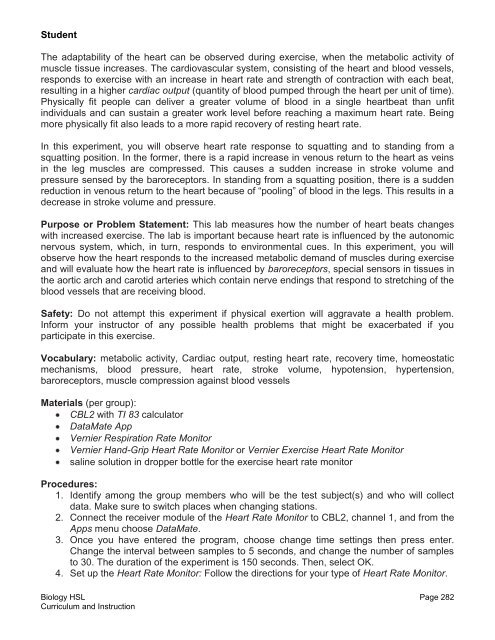Biology - HOT Science Lab
Biology - HOT Science Lab
Biology - HOT Science Lab
You also want an ePaper? Increase the reach of your titles
YUMPU automatically turns print PDFs into web optimized ePapers that Google loves.
Student<br />
The adaptability of the heart can be observed during exercise, when the metabolic activity of<br />
muscle tissue increases. The cardiovascular system, consisting of the heart and blood vessels,<br />
responds to exercise with an increase in heart rate and strength of contraction with each beat,<br />
resulting in a higher cardiac output (quantity of blood pumped through the heart per unit of time).<br />
Physically fit people can deliver a greater volume of blood in a single heartbeat than unfit<br />
individuals and can sustain a greater work level before reaching a maximum heart rate. Being<br />
more physically fit also leads to a more rapid recovery of resting heart rate.<br />
In this experiment, you will observe heart rate response to squatting and to standing from a<br />
squatting position. In the former, there is a rapid increase in venous return to the heart as veins<br />
in the leg muscles are compressed. This causes a sudden increase in stroke volume and<br />
pressure sensed by the baroreceptors. In standing from a squatting position, there is a sudden<br />
reduction in venous return to the heart because of ―pooling‖ of blood in the legs. This results in a<br />
decrease in stroke volume and pressure.<br />
Purpose or Problem Statement: This lab measures how the number of heart beats changes<br />
with increased exercise. The lab is important because heart rate is influenced by the autonomic<br />
nervous system, which, in turn, responds to environmental cues. In this experiment, you will<br />
observe how the heart responds to the increased metabolic demand of muscles during exercise<br />
and will evaluate how the heart rate is influenced by baroreceptors, special sensors in tissues in<br />
the aortic arch and carotid arteries which contain nerve endings that respond to stretching of the<br />
blood vessels that are receiving blood.<br />
Safety: Do not attempt this experiment if physical exertion will aggravate a health problem.<br />
Inform your instructor of any possible health problems that might be exacerbated if you<br />
participate in this exercise.<br />
Vocabulary: metabolic activity, Cardiac output, resting heart rate, recovery time, homeostatic<br />
mechanisms, blood pressure, heart rate, stroke volume, hypotension, hypertension,<br />
baroreceptors, muscle compression against blood vessels<br />
Materials (per group):<br />
CBL2 with TI 83 calculator<br />
DataMate App<br />
Vernier Respiration Rate Monitor<br />
Vernier Hand-Grip Heart Rate Monitor or Vernier Exercise Heart Rate Monitor<br />
saline solution in dropper bottle for the exercise heart rate monitor<br />
Procedures:<br />
1. Identify among the group members who will be the test subject(s) and who will collect<br />
data. Make sure to switch places when changing stations.<br />
2. Connect the receiver module of the Heart Rate Monitor to CBL2, channel 1, and from the<br />
Apps menu choose DataMate.<br />
3. Once you have entered the program, choose change time settings then press enter.<br />
Change the interval between samples to 5 seconds, and change the number of samples<br />
to 30. The duration of the experiment is 150 seconds. Then, select OK.<br />
4. Set up the Heart Rate Monitor: Follow the directions for your type of Heart Rate Monitor.<br />
<strong>Biology</strong> HSL Page 282<br />
Curriculum and Instruction

















